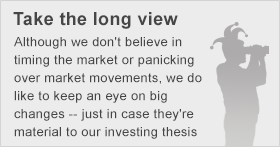
The allure of becoming a member of the S&P 500 (^GSPC +0.37%) is huge for small and mid-sized companies, as it marks a milestone in their corporate growth. Recently, though, with the Russell 2000 (RUSSELLINDICES: ^RUT) having endured a full 10% correction, investors have increasingly seen a discrepancies between large-cap and small-cap stock performance. Interestingly, when it comes to the mid-cap stocks that aspire to become the next S&P 500 members, the small-cap correction hasn't really had a marked impact. Let's take a look at the S&P MidCap 400 Index (SNPINDEX: ^MID) and some of its biggest components, including HollyFrontier (HFC +0.00%) and United Rentals (URI 0.97%), to see whether they're still positioned to be among the first stocks S&P Dow Indices looks at when it next considers elevating some select companies to the ranks of the S&P 500.
Mid-caps and the Goldilocks effect
Investors face a trade-off in considering the size of stock they choose to buy. Small-caps have a lot more growth potential than large-caps, giving them a bigger chance of seeing explosive share-price growth. But small-caps are younger than large-caps and therefore have a lot more business risk.

Are mid-caps just right? Image source: Flickr, courtesy Petr Kratochvil.
Mid-caps offer investors the best of both worlds. Most mid-caps have been around long enough to have established themselves as up-and-coming companies in their industries, and many of them have the growth potential that will eventually help them join the ranks of the S&P 500. They obviously don't offer quite as much growth as small-caps, but the greater stability makes them attractive to many risk-averse investors.
So far, we've seen that quality hold up for mid-caps over the past month or so:
Small-caps have fallen more than 5% in little more than a month, completing a 10% correction since earlier this year. But mid-caps have mostly performed in line with their S&P 500 counterparts.
The next S&P 500 members?
Moreover, when you look at some of the largest mid-caps, you can see more in common with large-caps than with small-caps. HollyFrontier has benefited greatly from the boom in U.S. oil production, with favorable prices for domestic crude helping drive up its profits through exports of refined products. Although HollyFrontier has had to deal with volatility in oil prices and with the potential long-term possibility that the U.S. will lift export restrictions on unprocessed crude, the refining giant has nevertheless focused on getting more value from its operations by increasing output and identifying lucrative product mixes.
Meanwhile, equipment rental company United Rentals has tapped into a huge trend, taking advantage of the reining in of capital expenditures throughout corporate America by offering a way for businesses to rent equipment on a temporary basis rather than buying it outright. At the same time, United Rentals has a sales operation as well, positioning itself to retain its customers even as the economy improves and they seek to buy equipment.
Obviously, there's no guarantee that mid-caps will continue to keep up with the S&P 500 or avoid the fate of the Russell 2000. For now, though, mid-caps offer an attractive middle ground between the risk of small-caps and the stability of large-caps.

